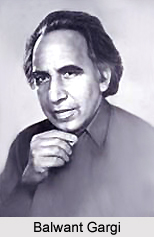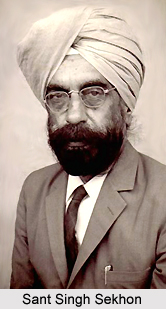 Punjabi drama has always been a mixture of the elements of English as well as Sanskrit drama. However, the impact of English drama, especially of Shakespeare, has been greater than that of traditional Sanskrit drama. In fact, Sanskrit drama and poetics, though they flourished in this land in ancient times, ironically, did not have much influence in shaping the drama developed in the twentieth century.
Punjabi drama has always been a mixture of the elements of English as well as Sanskrit drama. However, the impact of English drama, especially of Shakespeare, has been greater than that of traditional Sanskrit drama. In fact, Sanskrit drama and poetics, though they flourished in this land in ancient times, ironically, did not have much influence in shaping the drama developed in the twentieth century.
The writing of Punjabi plays had already started in the early part of the twentieth century. Some of the playwrights and works during this time include Bhai Vir Singh (Raja Lakhdata Singh, 1910), Kirpa Sagar (Maharaja Ranjit Singh and Dido Jamval), Bawa Budh Singh (1878-1931) (Chander Hart and Mundri Chhall (The Magical Ring)), Charan Singh (1853-1908) (Rani Sarab Kaur), Gurbax Singh Barrister (Mohan Bhaia, 1912), Brij Lai Shastri (Puraan Natak, 1919, Partigya, Vasva Datta, 1925). However, the first successful plays in Punjabi which was written in a realistic style along the lines of Western drama was by Ishwar Chander Nanda (1892-1966). His predecessors did follow models of Sanskrit plays, but Nanda started writing under the direct influence of Western drama. He came in contact with Norah Richards and Philips E. Richards of Dayal Singh College, Lahore, during his student days and started writing short plays in Punjabi. Dulhan (The Bride) and Bebe Ram Bhajni were Nanda`s two one-act plays, which pioneered modern Punjabi drama.
Nanda`s first one-act-play was staged in 1914, and his full-length play Subhadra was published in 1920. He has written two other full-length plays, War Gharjan Lily da Viah (1938) and Social Circle (1953), and a Punjabi adaptation of Shakespeare`s Merchant of Venice entitled Shamu Shah (1928). Besides these, he wrote over a dozen one-act plays, published in two collections, Jhalkare (Reflections, 1949) and Lishkare (Flashes, 1956).
The main themes of Nanda`s plays were the various social problems of the day. In Subhadra, he deals with the problem of widow remarriage; in Var Ghar Jan Lily da Viyah, he contrasts love marriage and arranged marriage; and in Social Circle, he portrays the urban, middle-class elite who arrange their "social meets" merely to promote their narrow commercial interests.
The most important contribution of Nanda`s plays is that, with them, Punjabi drama is freed from religious and mythological themes. He propagated new values through young men and women educated in schools and colleges. That is why he highlights mutual conflict between the two generations of the Punjabi middle class. To Nanda`s credit, while adopting Western techniques of drama, he made full use of the folk theater tradition of Punjab, blending the two in a brilliant pattern. His presentation of marriage scenes, religious ceremonies, superstitions, the ignorance of the village folks, folk songs and folk dances, and so on invests his plays with a Punjabi character.
 The later playwrights of Punjabi drama were greatly influenced by Nanda. They were the ones responsible for shaping the future Punjabi drama into a theater moulded and motivated by Western drama on realistic lines. Those who followed him included Joshua Fazal-ud-din (1903-73), Harcharan Singh (1914), Sant Singh Sekhon (1908), Balwant Gargi (1916), and a few others. The writers who were almost contemporaries of Nanda were Gurbakhsh Singh Preet Lari (1895-1978), Mohan Singh Dewana (1899-1984), Harcharan Singh, Gurdial Singh Khosla (1912), Roshan Lai Ahuja (1904-87), and Gurdial Singh Phul (1911-88).
The later playwrights of Punjabi drama were greatly influenced by Nanda. They were the ones responsible for shaping the future Punjabi drama into a theater moulded and motivated by Western drama on realistic lines. Those who followed him included Joshua Fazal-ud-din (1903-73), Harcharan Singh (1914), Sant Singh Sekhon (1908), Balwant Gargi (1916), and a few others. The writers who were almost contemporaries of Nanda were Gurbakhsh Singh Preet Lari (1895-1978), Mohan Singh Dewana (1899-1984), Harcharan Singh, Gurdial Singh Khosla (1912), Roshan Lai Ahuja (1904-87), and Gurdial Singh Phul (1911-88).
It may be noted that some of the writers of this generation were writing in other genres, and so drama and theater was not their stronghold. They were primarily writing drama only for enriching this form also; otherwise, they distinguished themselves in other forms of literature. For example, Dewana gained fame in poetry and literary scholarship, Gurbakhsh Singh in prose, and Sant Singh Sekhon in fiction and literary criticism, but a few of them devoted themselves wholeheartedly to drama. Except for Sant Singh Sekhon, most of these playwrights contributed to the growth of popular drama nurtured by Harcharn Singh. It was taken forward by Gurdial Singh Khosla, Roshan Lai Ahuja, and Gurdial Singh Phul, all playwrights of the first generation. These playwrights wrote on contemporary social, historical, and mythological themes. The dramatization of Sikh cultural ethos was also a favorite subject of these playwrights. The defining feature of these playwrights was their farcical or melodramatic impact, which did not rise above the level of Ram Lila performances. The various plays of this generation gained great popularity with the audience and their art remained untouched by modernism.



















